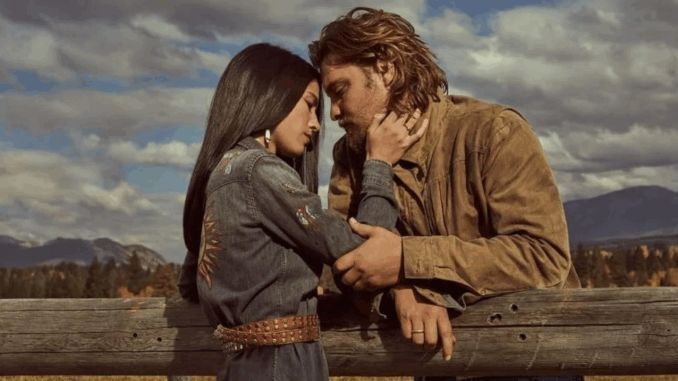
1. A Love Between Two Worlds: Native Identity and Ranching Legacy
Monica Long Dutton and Kayce Dutton’s relationship is built on deep love, but also constant cultural tension. Monica, a Native American woman from the Broken Rock Reservation, and Kayce, the youngest son of John Dutton—the patriarch of a powerful ranching dynasty—come from opposing worlds.
Their union challenges long-standing conflicts between Native sovereignty and settler colonialism. Monica never fully trusts the Dutton legacy, while Kayce constantly feels torn between his loyalty to his father and the life he’s chosen with Monica. This cultural divide has become one of the most powerful, thought-provoking dynamics in Yellowstone.
2. A Deep, Complicated, and Often Painful Love
Kayce and Monica’s love is sincere but frequently fractured by hardship. From Kayce’s violent past to Monica’s emotional withdrawal, their story is marked by separation, reconciliation, and uncertainty.
They split early in the series over Kayce’s killing of a man (in self-defense), and even after reconciling, they continue to drift apart over time. Their love feels fragile, tested by loss, trauma, and conflicting values—yet, they never quite let go of each other.
Some viewers find their love story beautifully raw; others find it exhausting or directionless.
3. A Heartbreaking Loss That Changed Everything
One of the most devastating moments in Yellowstone comes when Monica, pregnant with their second child, is involved in a car accident on the way to the hospital. Their newborn son dies shortly after birth.
This tragedy is portrayed with painful realism—grief that doesn’t scream, but sinks deep.
For many viewers, it’s a standout moment of emotional authenticity. Others, however, criticized it as overly manipulative, using tragedy to artificially raise the emotional stakes.
4. Kayce’s Vision: “I Saw the End of Us”
In a spiritual Lakota ritual meant to guide his future, Kayce undergoes a vision quest. After days in isolation, he returns visibly shaken. When Monica asks what he saw, he simply says:
“I saw the end of us.”
This brief line became one of the most chilling and ambiguous moments in the series. Fans continue to debate its meaning—does it foreshadow death, divorce, or something metaphysical?
It has fueled speculation for seasons, remaining one of the show’s most mysterious and discussed scenes.
5. Monica: A Divisive Character
Among the Yellowstone fandom, Monica is one of the most polarizing characters.
To some, she is strong, intelligent, and a rare voice of moral clarity. She represents Native culture with integrity and grace.
To others, she is frustrating—seen as overly emotional, reactive, and indecisive. Her frequent changes of heart regarding Kayce and the ranch life make some fans question the consistency of her character arc.
Regardless, her presence forces viewers to confront uncomfortable truths about land, history, and identity.
6. Love Without Fireworks: Subtle, Honest, and Often Overlooked
Unlike the explosive romance of Beth and Rip, Monica and Kayce offer a more subdued, realistic portrait of love. Their struggles are domestic, spiritual, and deeply personal.
This quietness can be refreshing for some viewers, who appreciate the emotional weight. Others see their relationship as lacking energy or intrigue.
But for those who’ve experienced grief, cultural identity struggles, or the pain of distance in marriage, Monica and Kayce feel painfully real.
7. Fan Reactions and Online Discussions
Monica and Kayce consistently divide fan opinion on Reddit, Twitter, and Yellowstone forums.
-
Supporters call them “the emotional core of the show,” praising their authenticity and depth.
-
Critics find their storyline too slow, repetitive, or disconnected from the main action.
Some fans even speculate that Kayce’s vision means he will die before the series ends—perhaps fulfilling the prophecy of “the end of us.”
Conclusion
Monica and Kayce’s love story is not one of passion and power, but of pain, sacrifice, and cultural reckoning. It doesn’t seek to entertain with spectacle—it asks viewers to sit with discomfort, grief, and questions of belonging.
Their story may not be the loudest in Yellowstone, but it just might be the most human.
